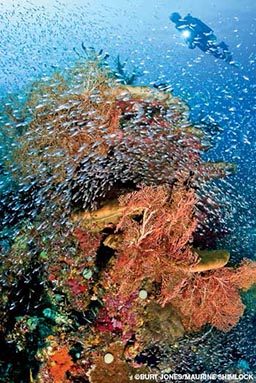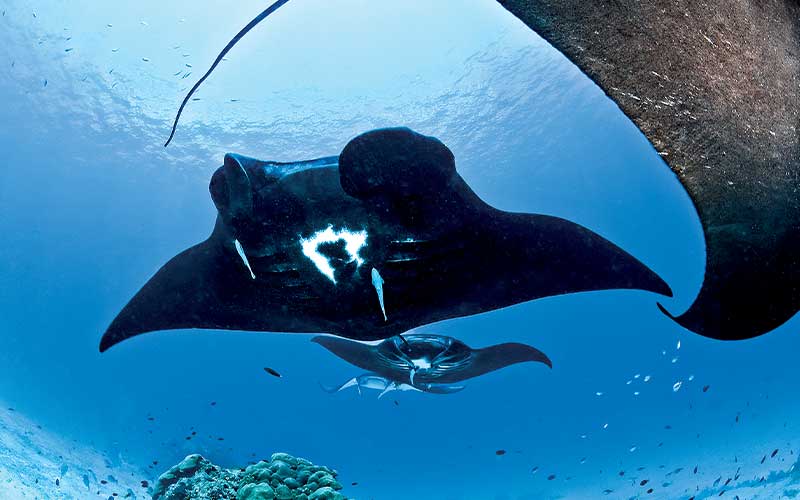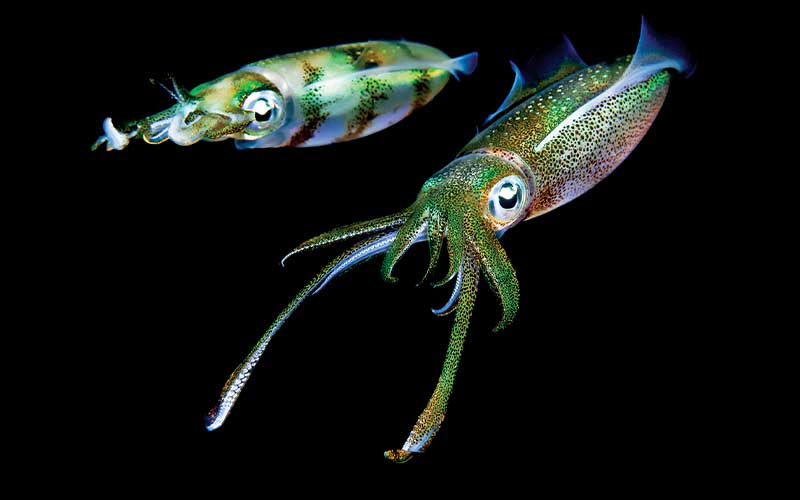“Do you ever feel like trying something different, maybe a little easier?” I asked.
“Do you mean following the crowd instead of blazing the trail?” he answered.
“I guess that’s what I mean, but I already know we won’t do it.”
I remember that conversation well. It was September 2008, and my husband, Burt, and I were attempting sleep on the deck of an aging liveaboard cursed with a problematic electrical system. Anchored off Waigeo Island in the Raja Ampat regency of Indonesia’s West Papua province, our miniscule cabin fan had stopped turning hours before, and it was sweat-dripping hot at midnight. It mattered, but not enough to make me want to leave. We were being paid to survey and photograph never-before-dived reefs for a guidebook to be published the next year. More important, we were where we loved to be: out there.

People who know our work would probably classify us as photojournalists who specialize in marine life. People who know us, however, understand we think of ourselves as “destination developers.” We are excited by the challenges of finding world-class dive sites and establishing avenues for marine tourism to become an economic alternative to the exploitation of the sites’ natural resources.
Usually we explore a place, photograph it, write about it and move on. But for the past decade we have been actively involved in building Raja Ampat, Triton Bay and Cenderawasih Bay, Raja Ampat’s neighbors to the south and east, into “must-do” destinations for serious traveling divers. The entire contiguous area is so vast — more than 70,650 square miles (roughly the size of North Dakota) — that a new term, “seascape,” was needed to describe it. In 2004, this marine wonderland was designated the Bird’s Head Seascape and became our new stomping grounds.
I often think about the month we spent completing our first survey of Raja Ampat. I don’t dwell on the uncomfortable times like the nights the heat forced us on deck. When I reminisce, I think about days like the one toward the end of our initial survey when we opened the doors of discovery to a particularly special site. On the last dive of the day, we descended over a channel that led to two magnificent undersea pinnacles crammed with sea fans and soft corals. No one else had ever dived there, and we moved easily through curtains of fish that didn’t seem to care whether we were there or not. We named the site Love Potion Number 9, and it remains one of our favorite dives in all the Bird’s Head. Discovering sites like that one gets into your system, and you start wishing your assignment would last forever.
So far we are still out here, witnesses to the good, the bad and most of all, the contradictory. Although we love the Bird’s Head Seascape, as we love all places where wildlife outnumbers people, we didn’t really understand it until we started working to preserve it. At first we might have wished for better visibility at times, but with familiarity comes awareness that the rich mass of plankton clouding the water is what nourishes all those fish and corals. It also seems somewhat contradictory to encourage Papuans to embrace modernism and welcome tourists when they believe that everything, including “their reefs,” is imbued with an ancestral spiritual power most westerners do not comprehend.
We happen to think these contradictions are what make the place so interesting and filled with potential. The Bird’s Head Seascape is a wilderness on the verge of transition. There is no going back, and moving forward will either destroy an entire tropical ecosystem or preserve one of nature’s most extravagant creations. We have been fortunate to work with people dedicated to the latter.

Preserving Bird’s Head Seascape
A few years ago, our old friend and one of the world’s foremost ichthyologists, Gerry Allen, played matchmaker between us and Mark Erdmann, regional coordinator and ocean expert for Conservation International’s Bird’s Head Seascape program. Erdmann knew we had been diving in the region since 2002 and that we could write, photograph and didn’t mind getting a bit hot and dirty as long as we could explore, dive and produce books about our discoveries.
From this contact and collaboration emerged our first guidebook on the area, Diving Indonesia’s Raja Ampat, published in 2009, and now we’ve expanded the scope and produced a completely new guide, Diving Indonesia’s Bird’s Head Seascape, that covers the entire region. Both Erdmann and Allen firmly believe (and the data support) there is no equal to the Bird’s Head Seascape in numbers of fish and coral species, habitat diversity and overall marine biodiversity. The Seascape shelters fringing reefs, lagoons, bays, mangroves, deep drop-offs, sea-grass beds and black-sand critter sites. So far scientists have documented 1,629 fish species, 569 coral species (10 times more than the entire Caribbean), the Pacific Ocean’s most-utilized leatherback turtle nesting beach, dependable manta ray and whale shark aggregations, World War II wrecks and a whopping 57 species of mantis shrimp.

Erdmann, especially, has taken a very organic, whole-system approach to conservation and has tried to integrate the biological, geopolitical, ecological and economic aspects, especially as they relate to the needs of the Seascape’s human population, into an overall conservation plan. One of our primary missions has been to discover new dive areas, thus bringing tourism to the Seascape’s far-flung coastal villages. Between the Raja Ampat guide and the new Seascape guide, we have identified more than 200 sites, including more than 50 new ones we hope will turn tourism into a viable asset for local communities throughout the region.
Erdmann and Allen are not your typical field biologists. They call each other unprintable names, play practical jokes, stay up late caring for their specimens and writing reports, and then they wake up early to count fish. These are the guys who coined the terms “species factory” (Triton Bay), “the bull’s-eye of marine biodiversity” (Raja Ampat) and “evolutionary cauldron, the terrestrial equivalent of the Galapagos” (Cenderawasih Bay).

They also came up with the idea for the Blue Auction, a black-tie event hosted by Prince Albert of Monaco, where rights to name newly discovered species were auctioned to some very wealthy people. Allen says, “After Mark and I collected a couple of new species of walking sharks, one from Cenderawasih Bay and one from Triton Bay, we were sitting around — I’m sure a beer or two were involved — and Mark brought up the idea of making some money from naming these animals that could be plowed back into saving them. One of our notions was to sell the naming rights. At first it was just a pipe dream, but it had been done before so there was a precedent.” The Blue Auction raised more than $2 million for things such as field stations, floating ranger stations and scholarships for Indonesian marine science students. Importantly, the money was recirculated to where it mattered most: the Bird’s Head.
Erdmann and Allen taught us how nongovernmental organization (NGO) funding is prioritized and why marine surveys are crucial to preservation. It actually unfolds quite a bit differently than we originally believed. The science has to happen first; without ongoing scientific characterization there would be no way to assess correctly which areas to target and preserve. During the scientific characterization period, NGO staff work with the local population to gain their trust and impart to them a sense of ownership and responsibility.
Surveying the Sites

What actually happens during these assessment surveys? How do the scientists and we figure out where the most fish and coral live, what they are and how a site should be dived? This is the fun part. It’s not like a liveaboard, where the standard routine is breakfast, dive, second breakfast, dive, lunch, rest and dive again. We grab something to eat and everyone gets in the water as quickly as possible. Often, we hardly communicate with each other again until evening.
The science contingent’s plan usually takes Erdmann to significant depths; even in remote areas the prime sites for hunting new species tend to be deep. He stages tanks and reluctantly submits to hours of decompression time. His ability to identify fish in the dark depths is amazing. If he finds something interesting he’ll bring it to Allen, who stays shallower to count species and photograph. Both of them have an encyclopedic knowledge of fish, including their Latin names, habits, habitats and more. Imagine being on a boat with two guys who can answer all your identification questions and then tell you the story of when and where they discovered one of the fish you just asked about.

While Erdmann, Allen and any other scientists who are diving with us go off to their respective study sites, Burt and I hook up to powerful scooters that allow us to survey 10 times the area we could using fin power alone. The biggest challenge is deciding where to start. We study charts, talk to anyone who has been in an area before us and rely on our instincts. Using a scooter while holding a camera is a bit tricky, so if one of us finds something extraordinary, we go back to the liveaboard and grab the appropriate housing. Usually stopping only to charge scooter batteries and fill tanks, we check our GPS readings and make careful notes about the sites, including how we dived them and what we saw. When we do get a chance to take a few shots, we have to do it right the first time. Everyone involved in these surveys has an agenda, and none of them include going back to an already-surveyed site because a lens cap was left on.
When we were in Cenderawasih Bay last year, our primary goal was to find and interact with whale sharks that feed under lift-net fishing platforms called bagans, found throughout the southern part of the bay. Locating animals as big as whale sharks was easy, but as we worked our way around their feeding grounds, other fish identifications stumped us more than they usually do. We constantly saw fish that seemed out of place or were colored a bit differently. When we photographed a Burgess’ butterflyfish in about 20 feet of water, we couldn’t believe what we were seeing because they are usually found deeper than 100 feet. “That’s the beauty of this place,” Allen explained. “Eons ago, major tectonic plate movement repeatedly blocked the mouth of the bay. After sea levels dropped during the Pleistocene, shallow reefs died off and only deeper reefs survived, but now in shallower water. Normally deep-dwelling species like Burgess’ butterflyfish stayed shallow even after sea levels rose again because the size of the bay limits water movement and outside species recruitment, meaning little competition for the shallower niches.”

If Cenderawasih Bay is a fish nerd’s paradise complete with weird variants and the largest fish in the ocean, and Raja Ampat is the marine world’s richest repository of fish and corals, then what makes Triton Bay a “species factory?” When the first Triton Bay surveys were conducted in late 2006, scientists were looking for a “hot spot,” an area of maximum species diversity and endemism. Allen explained, “This is where all the data I collect comes in. With this hot-spot data I can tell an organization where they need to set up their network to capture the whole of fish diversity. Conservation International has been very successful using the targeted hot-spot approach to save terrestrial species, and we are trying to use some of the same philosophies for saving marine species.”
In 12 days, more than 20 species of marine life were discovered, more than 70 dive sites were surveyed, and Allen established a new world record for fish diversity: 330 species on a single site. We had a very difficult time pulling ourselves away from the sites around Selat Iris, especially Bo’s Rainbow and Little Komodo, because the soft corals and fish life were some of the most prolific we’ve ever seen. When upwellings turned the sea Coke-bottle green, we looked beyond the profusion of color and found a surprising number of frogfish, unusual shrimp, crabs and mimic octopus.

Like its neighboring Seascape regions, Triton Bay’s turbulent geological history has affected the evolution of its marine life. But Triton’s high endemism is most notably due to the huge volume of fresh water flowing from the West Papuan mainland into the sea. Most marine larvae cannot survive in a low-saline environment, and neither Raja Ampat nor Cenderawasih contain great estuaries like Triton’s Arguni and Etna bays. Sandwiched between these two enormous freshwater outflows, Triton’s marine larvae have developed on cloistered reefs and traveled their own evolutionary path.
Anointed by storms, caressed by monsoon winds, embraced by jungles, towering mountains, sandy beaches and rocky shores, the Bird’s Head Seascape evokes a sense of what tropical wildernesses must have been like before most of them were logged, mined, dynamited and relegated to mere remnants. This is a place where birds of paradise dance in trees, where endangered turtles nest on secluded beaches, where sharks “walk” over coral and where divers can get close to manta rays, whale sharks and more than 1,600 other fish species. We know there is a risk in developing the Bird’s Head into a world-renowned dive destination if visitors do not learn to respect its natural rhythms, including those of its human inhabitants. And even though we realize the thrill of discovery is ephemeral, we believe the Bird’s Head Seascape will endure, kept safe and productive through the coordinated and enlightened efforts of government, citizens, NGOs and visitors.

© Alert Diver — Q4 Fall 2011